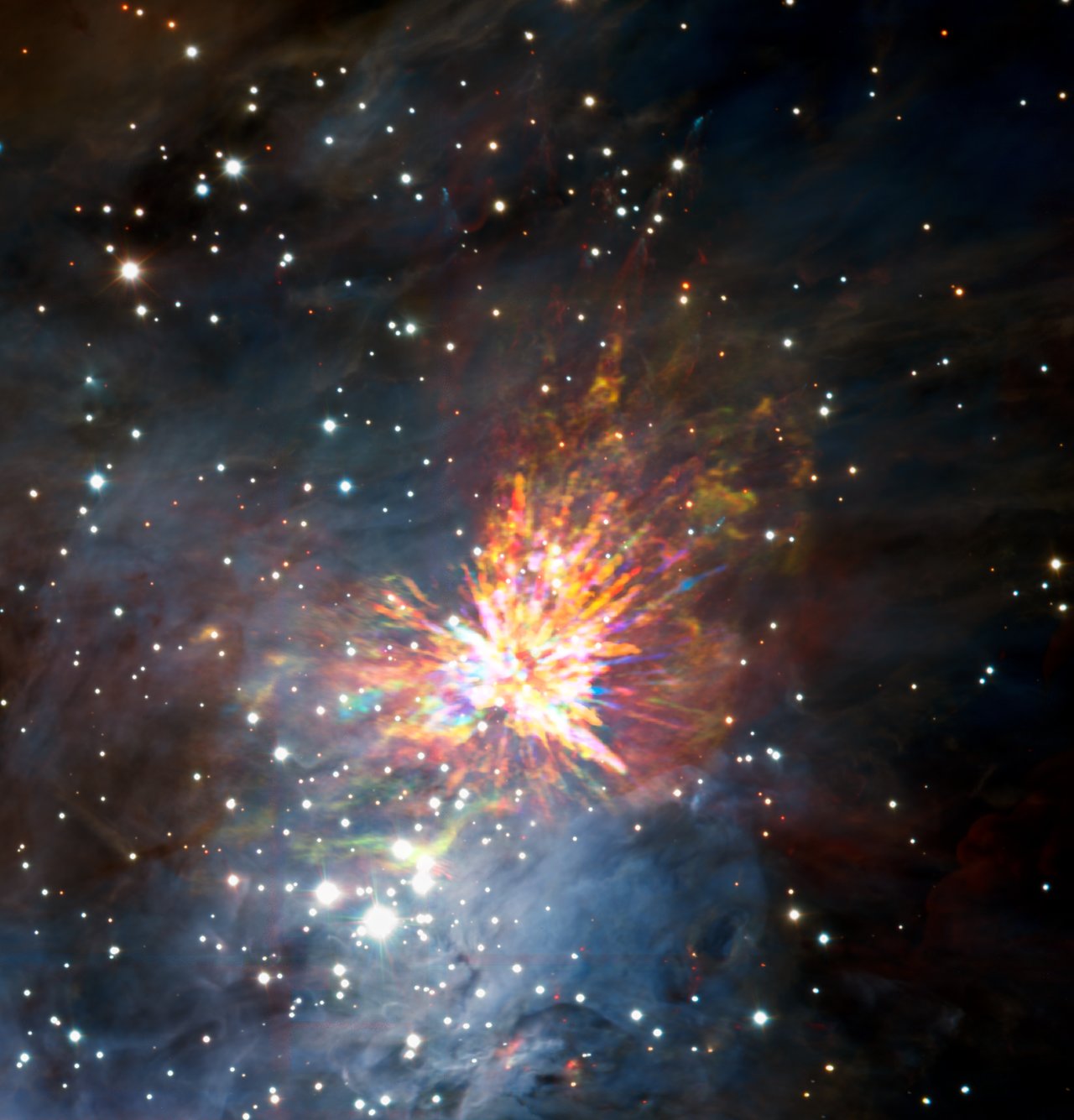It looks like you're using an Ad Blocker.
Please white-list or disable AboveTopSecret.com in your ad-blocking tool.
Thank you.
Some features of ATS will be disabled while you continue to use an ad-blocker.
19
share:
500 years ago , in a nebula far far way two young Stars bumped into each other producing an explosion that released as much energy as our Sun emits in
10 million years , today we get to see the result of that meeting.
The collision happened in the Orion Nebula and was captured by ESO using the Atacama Large Millimeter/submillimetre Array in Chile.

In this short video from ESO we travel into the Nebula to reveal the remnants of the collision.
The collision happened in the Orion Nebula and was captured by ESO using the Atacama Large Millimeter/submillimetre Array in Chile.

In this short video from ESO we travel into the Nebula to reveal the remnants of the collision.
About 100 000 years ago, several protostars started to form deep within the OMC-1. Gravity began to pull them together with ever-increasing speed, until 500 years ago two of them finally clashed. Astronomers are not sure whether they merely grazed each other or collided head-on, but either way it triggered a powerful eruption that launched other nearby protostars and hundreds of colossal streamers of gas and dust out into interstellar space at over 150 kilometres per second. This cataclysmic interaction released as much energy as our Sun emits in 10 million years
The new ALMA images, however, showcase the explosive nature in high resolution, unveiling important details about the distribution and high-velocity motion of the carbon monoxide (CO) gas inside the streamers. This will help astronomers understand the underlying force of the blast, and what impact such events could have on star formation across the galaxy.
www.eso.org...
I forget where I heard it. I am thinking it was Sagan. I remember it being said that the Andromeda galaxy is on a collision course with the Milky
Way and the thing is that the galaxies collide yet it is possible for not a single star to collide with each other. I thought that was pretty amazing
to think about.
Thanks for this. The Universe just never ceases to amaze.
Thanks for this. The Universe just never ceases to amaze.
Well, I hope that doesn't happen here, I don't want to be part of a fireworks display.
1350 light years away, in the constellation of Orion (the Hunter), lies a dense and active star formation factory called the Orion Molecular Cloud 1 (OMC-1),
Ok. Cool. No problem.
500 years ago two of them finally clashed.
...
Fast forward 500 years, and a team of astronomers
...used the Atacama Large Millimeter/submillimeter Array (ALMA) to peer into
...the debris from the explosive birth of this clump of massive stars, looking like a cosmic version of fireworks with giant streamers rocketing off in all directions.
Huh?
Now you wait just a cotton pickin' minute here!
If it takes 1,350 years for light to travel to Earth, you aren't going to be able to detect with your telescope something that happened 500 years ago!
The light from that event would only have had time to travel, 500 light-years, on a 1,350 light-year journey.
Why, this is an outrage!
I demand an explanation.
I have often wondered what would happen if two stars collided, i have finally got my answer... Amazing
originally posted by: wildespace
a reply to: 3n19m470
Don't worry, I got it.
The image shows the aftermath of a collision that happened 500 years ago (using local time). With light having to travel to us for 1,350 years, that means the collision happened 1,850 years ago.
That's not what was claimed, was it.
About 100 000 years ago, several protostars started to form deep within the OMC-1. Gravity began to pull them together with ever-increasing speed, until 500 years ago two of them finally clashed.
new topics
top topics
active topics
-
Petition Calling for General Election at 564,016 and rising Fast
Political Issues • 94 • : Freeborn -
-@TH3WH17ERABB17- -Q- ---TIME TO SHOW THE WORLD--- -Part- --44--
Dissecting Disinformation • 3384 • : brewtiger123 -
BIDEN Admin Begins Planning For January 2025 Transition to a New President - Today is 4.26.2024.
2024 Elections • 59 • : WeMustCare -
DOJ Special Counsel Robert HUR Says JOE BIDEN Can Be ARRESTED After Jan 20th 2025.
Above Politics • 30 • : WeMustCare -
On Nov. 5th 2024 - AMERICANS Prevented the Complete Destruction of America from Within.
2024 Elections • 160 • : WeMustCare -
Results of the use of the Oreshnik missile system in Dnepropetrovsk
World War Three • 240 • : 777Vader -
Both KAMALA and OBAMA are on the Nov 5th 2024 Ballot - If One Loses - Both Lose.
2024 Elections • 9 • : WeMustCare -
How many people, in GENERAL, are musically inclined?
Music • 26 • : Huronyx -
Well, here we go red lines crossed Biden gives the go ahead to use long range missiles
World War Three • 395 • : annonentity -
Federal law trumps state and local law every time
Social Issues and Civil Unrest • 30 • : ADVISOR
19
